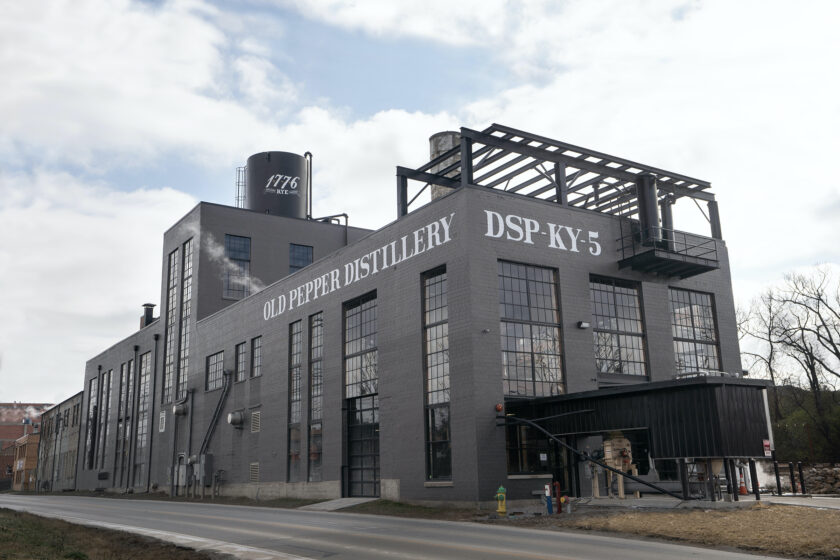James E. Pepper Distillery
James E. Pepper Co. is the passionate revival of one of America’s most celebrated and significant Kentucky whiskey brands. After a fifty-year gap in production, James E. Pepper—and its county seat in Lexington—have been painstakingly revived as a nimble craft distillery, offering benchmark Kentucky whiskeys that are both independently sourced from other Kentucky producers and crafted at the refurbished distillery using the brand’s historical mash bills.
The most recent chapter in the history of James E. Pepper begins in 2008, when barman and aspiring sportswriter Amir Peay became intrigued by an old photograph of “the Fight of the Century,” an event that took place on July 4, 1910, between Jack Johnson— the first black world heavyweight boxing champion—and James J. Jeffries. Apart from the significance of the fight itself (the Civil War had ended less than 50 years earlier; it was the height of the Jim Crow era in the US), what caught Peay’s eye was a sponsorship banner in the photograph that featured the name of a whiskey he had never heard of: “James E. Pepper Whisky, ‘Born with the Republic.’”
The story behind this historical brand was that of one of the first families of American whiskey and began with Elijah Pepper, born in 1760 in Fauquier County, Virginia. In the 1790s he moved his family west and began distilling in Kentucky—what was then the very edge of the nation’s frontier. Elijah died in 1831 and his son Oscar continued his father’s legacy, expanding the family business and building a larger distillery (what would be known, famously, as the Old Oscar Pepper distillery, later owned by Labrot & Graham of Woodford Reserve fame). He also began working with Scottish chemist Dr. James C. Crow to perfect the sour mash fermentation. Pepper whiskeys grew in fame, being favored by Andrew Jackson and Henry Clay, Daniel Webster and Ulysses S. Grant.
Oscar Pepper died in 1865. James E. Pepper, the modern distillery’s namesake, had been born in 1850. A minor when he inherited the family business, James grew up under the tutelage (and financial guidance) of E.H. Taylor, to whom he later lost his first Louisville distillery to pay off debts. While James E. Pepper was devoted to his business, he also led a colorful, lavish lifestyle (his chief diversion was training and racing thoroughbred racehorses). Seemingly always straddling the line between fabulous wealth and ruin, he actively promoted his whiskey, traveling the country in a private railroad car painted with the brand’s logo. A bright light even by Gilded Age standards, he rubbed shoulders with fellow barons at New York’s Waldorf-Astoria Hotel, buying rounds of Old Fashioned cocktails he had come to enjoy back in Kentucky at the Pendennis Club. When he wasn’t the life of the party, he also lobbied for whiskey makers to be able to bottle their own product and laid the foundation for the Bottled in Bond act of 1897.
James E. Pepper died from a fall on an icy New York sidewalk in 1906. His company was sold to an ownership group whose first task was to navigate Prohibition, which they did by bottling “medicinal” whiskey. The distillery then burned down in 1934, but such was the strength of the brand that it was rebuilt, and continued operating through the 1960s when, like so many American whiskey producers, it finally succumbed to changing tastes and a lack of demand. The brand was abandoned and the distillery buildings fell into ruin.
What survived, and what would fuel Amir Peay’s imagination years later, was a wealth of old recipes and distillery designs, as well as original bottlings. Peay assiduously collected these artifacts, becoming more intrigued as his collection grew, and began forming a plan to revive the brand after aquiring it in 2008. He re-dug the well under the distillery, connecting to the original limestone-rich water source. He approached Vendome Copper and Brass Works (armed with the original engineering plans from the still they had constructed in 1934) about building a new still. He contracted with established distillers to provide spirit for the company’s flagship 1776 offerings. He began distilling his own spirit in 2017. He built an 11,000-barrel rickhouse in 2021.
Critically, Peay and his team have been able to evoke a very rich history without becoming beholden to it. That said, as a point of pride, Peay was able to secure the facility’s original distilling number (DSP-5-KY), one of the vaunted single-digit codes that are associated with some of the bigger and older players in the Kentucky whiskey universe.




